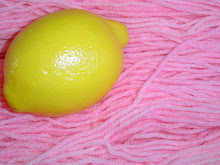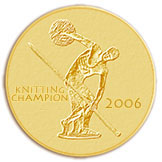Cake with a Twist

Remember the yarn I dyed last Friday? Here it is! Just to recap, I picked up some laceweight kid mohair and merino in ivory at my LYS. I wound the ball onto my niddy noddy and tied it off so it wouldn't get all crazy on me in the dye pot. Then I took a pot of cold water, dumped in a nice amount of white vinegar - several glugs worth - and added the dye. I used Wilton's cake decorating colors first in Delphinium Blue, then the Royal Blue. I had dropped a blob of dye into some water in a shaker and shook it up to dissolve it before dumping it into the pot. Then I dropped in the yarn, squashed it under the water and put the whole thing on the stove. I turned the stove on medium low and just let it cook. You don't want the water to boil or really even simmer because it could make the yarn felt. After about 20 minutes or so, the dye was exhausted from the water (the water was clear again), but I didn't like how purple the yarn was - I was going for more of a blue with some purple, not a purple with some blues. This is fairly common with blue colors as the dye molecule for blue is the largest and the red dye molecule is the smallest. Red strikes faster than blue, which needs extra time to strike properly. So anyway, I mixed up some Royal Blue with water and dumped that into the pot, gently stirring or moving the skein of yarn around to make sure that the dye could get all over the yarn. Then I left it on the heat for 45 minutes or so. The dye had again exhausted around 20 minutes, but its important to continue cooking the skein so that the dye molecules can actually bond with the yarn molecules.
Once it was done, I washed the skein in hot water and hung it to dry. Really cool side note: you can't see it on the computer, but the fuzzy halo of the yarn is purple while the core of the yarn is an ultramarine blue. It looks really cool and almost iridescent. When the skein was dry I wound it off on my ball winder and started knitting a mobius neck ring. I used the mobius cast on (I can't remember where it is, but if you Google mobius cast on, you'll find it) and started knitting using the English Mesh Lace pattern from the first Barbara G. Walker knit stitch patterns book. The really cool thing about this cast on is that as you look at the knitting, to the right of the cast on, you see the stockinette side of the pattern and to the left of the knitting you see the reverse stockinette side of the pattern, so you don't have to worry about the right or wrong side of your pattern at the mobius flip, it just works out that you see both of them.










0 Comments:
Post a Comment
<< Home